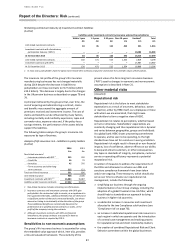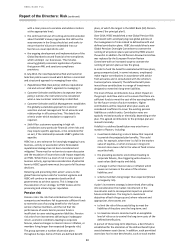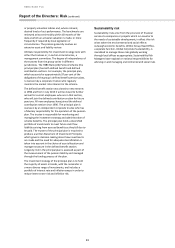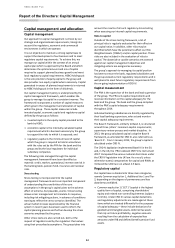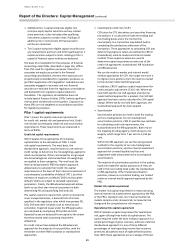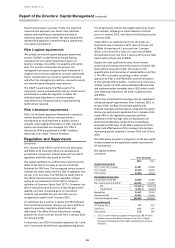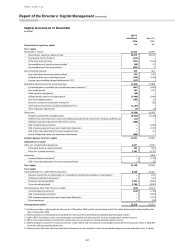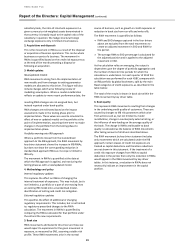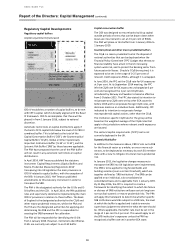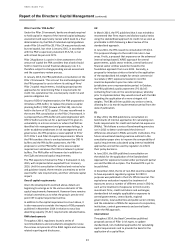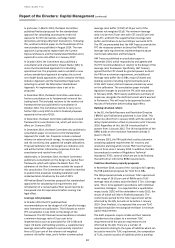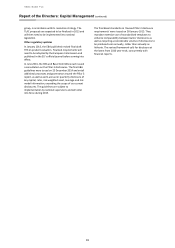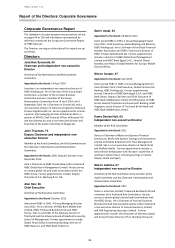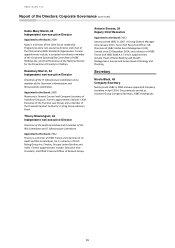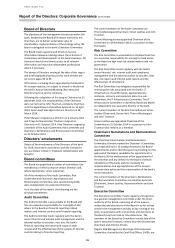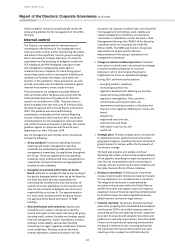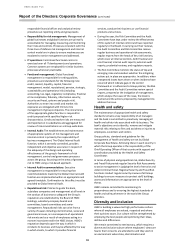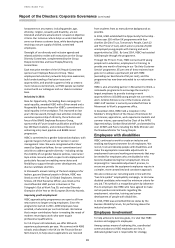HSBC 2014 Annual Report Download - page 93
Download and view the complete annual report
Please find page 93 of the 2014 HSBC annual report below. You can navigate through the pages in the report by either clicking on the pages listed below, or by using the keyword search tool below to find specific information within the annual report.
HSBC BANK PLC
Report of the Directors: Capital Management (continued)
91
Pillar 2 and the ‘PRA buffer’
Under the Pillar 2 framework, banks are already required
to hold capital in respect of the internal capital adequacy
assessment and supervisory review which leads to a final
determination by the PRA of individual capital guidance
under Pillar 2A and Pillar 2B. Pillar 2A was previously met
by total capital, but since 1 January 2015, in accordance
with the PRA’s supervisory statement SS 5/13, is met
with at least 56 per cent CET1.
Pillar 2A guidance is a point in time assessment of the
amount of capital the PRA considers that a bank should
hold to meet the overall financial adequacy rule. It is
therefore subject to change pending annual assessment
and the supervisory review process.
In January 2015, the PRA published a consultation on the
Pillar 2 Framework. This sets out the methodologies that
the PRA proposed to use to inform its setting of firms’
Pillar 2 capital requirements, including proposing new
approaches for determining Pillar 2 requirements for
credit risk, operational risk, counterparty credit risk and
pension obligation risk.
As part of CRD IV implementation, the PRA proposed to
introduce a PRA buffer, to replace the previous capital
planning buffer (‘CPB’) (known as Pillar 2B), also to be
held in the form of CET1 capital. This was reconfirmed in
the recent PRA consultation on the Pillar 2 framework. It
is proposed that a PRA buffer will avoid duplication with
CRD IV buffers and be set for a particular firm given its
vulnerability in a stress scenario or where the PRA has
identified risk management and governance failings. In
order to address weaknesses in risk management and
governance, the PRA propose a scalar applied to firms’
CET1 Pillar 1 and Pillar 2A capital requirements. Where
the PRA considers there is overlap between the CRD IV
buffers and the PRA buffer assessment, the PRA
proposes to set the PRA buffer as the excess capital
required over and above the CCB and relevant systemic
buffers. The PRA buffer will however be in addition to
the CCyB and sectoral capital requirements.
The PRA expects to finalise the Pillar 2 framework in July
2015, with implementation expected from 1 January
2016. Until this consultation is finalised and revised rules
and guidance issued, there remains uncertainty as to the
exact buffer rate requirements, and their ultimate capital
impact.
Overall capital requirements
Given the developments outlined above, details are
beginning to emerge as to the various elements of the
capital requirements framework. However there remains
residual uncertainty as to what the group’s precise end
point CET1 capital requirement will be.
In addition to the capital requirements set out above, it
is also necessary to consider the impact of FSB proposals
published in November 2014 in relation to total loss
absorbing capacity (‘TLAC’) requirements detailed below.
RWA developments
Throughout 2014, regulators issued a series of
recommendations and consultations designed to revise
the various components of the RWA regime and increase
related reporting and disclosures.
UK
In March 2014, the FPC published that it was minded to
recommend that firms report and disclose capital ratios
using the standardised approach to credit risk as soon as
practicable in 2015 following a Basel review of the
standardised approach.
In June 2014, the PRA issued its consultation CP12/14.
This proposed changes to the credit risk rules in two
areas. Firstly, a proposal that exposures on the advanced
internal ratings-based (‘AIRB’) approach for central
governments, public sector entities, central banks and
financial sector entities would be moved to the
foundation approach from June 2015. Secondly, a
proposal to introduce stricter criteria for the application
of the standardised risk weight for certain commercial
real estate (‘CRE’) exposures located in non-EEA
countries dependent upon loss rates in these
jurisdictions over a representative period. In October,
the PRA published a policy statement (‘PS 10/14’)
containing final rules on the second proposal, whereby
prior to implementation they would consult with the EBA
regarding the application of a more stringent risk
weights. The EBA will then publish any stricter criteria,
allowing for a six month implementation period from the
date of publication.
EU
In May 2014, the EBA published a consultation on
benchmarks of internal approaches for calculating own
funds requirements for credit and market risk exposures
(RWAs). This follows a series of benchmarking exercises
run in 2013 to better understand the drivers of
differences observed in RWAs across EU institutions. The
future annual benchmarking exercise outlined in the
consultation paper aims to improve the comparability of
capital requirements calculated using internal modelled
approaches and will be used by regulators to inform
their policy decisions.
In June 2014, the EBA published a consultation on
thresholds for the application of the Standardised
Approach for exposures treated under permanent partial
use and the IRB roll-out plan. The finalised RTS is yet to
be published.
In December 2014, the list of non-EEA countries deemed
to have equivalent regulatory regimes for CRD IV
purposes was published in the EU’s Official Journal. This
equivalence evaluation impacts the treatment of
exposures across a number of different areas in CRD IV,
such as the treatment of exposures to third country
investment firms, credit institutions and exchanges;
standardised risk weights applicable to exposures to
central governments, central banks, regional
governments, local authorities and public sector entities;
and the calculation of RWAs for exposures to corporates,
institutions, central governments and central banks
under the IRB approach.
International
Throughout 2014, the Basel Committee published
proposals across all Pillar 1 risk types, to update
standardised, non-modelled approaches for calculating
capital requirements and to provide the basis for the
application of a capital floor.


